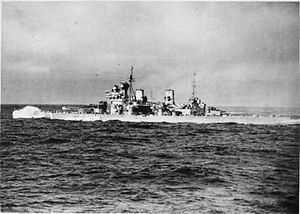
Back Дук оф Йорк (линеен кораб, 1940) Bulgarian HMS Duke of York (17) Catalan HMS Duke of York (17) Czech HMS Duke of York (17) German HMS Duke of York (17) Spanish اچاماس دوک آف یورک (۱۷) Persian HMS Duke of York (17) Finnish HMS Duke of York (17) French אה"מ דיוק אוף יורק (1940) HE HMS Duke of York Hungarian
 HMS Duke of York in March 1942, while escorting Convoy PQ 12
| |
| History | |
|---|---|
| Name | HMS Duke of York |
| Namesake | George VI (previously the Duke of York)[1] |
| Ordered | 16 November 1936 |
| Builder | John Brown and Company, Clydebank |
| Laid down | 5 May 1937 |
| Launched | 28 February 1940 |
| Commissioned | 4 November 1941 |
| Decommissioned | November 1951 |
| Stricken | 18 May 1957 |
| Identification | Pennant number: 17 |
| Fate | Scrapped in 1957 at Shipbreaking Industries, Ltd., Faslane, Scotland |
| General characteristics | |
| Class and type | King George V-class battleship |
| Displacement | 42,076 long tons (42,751 t) deep load |
| Length |
|
| Beam | 103 ft 2 in (31.4 m) |
| Draught | 34 ft 4 in (10.5 m) |
| Installed power |
|
| Propulsion | 4 sets Parsons geared turbines |
| Speed | 28.3 knots (52.4 km/h; 32.6 mph) |
| Range | 15,600 nmi (28,900 km; 18,000 mi) at 10 knots (19 km/h; 12 mph) |
| Complement | 1,556 (1945) |
| Sensors and processing systems | |
| Armament |
|
| Armour |
|
| Aircraft carried | 4 × Supermarine Walrus seaplanes |
| Aviation facilities | 1 × double-ended catapult |
HMS Duke of York was a King George V-class battleship of the Royal Navy. Laid down in May 1937, the ship was constructed by John Brown and Company at Clydebank, and commissioned into the Royal Navy on 4 November 1941, subsequently seeing combat service during the Second World War. In mid-December 1941, Duke of York transported Prime Minister Winston Churchill to the United States to meet President Franklin D. Roosevelt. Between March and September 1942 Duke of York was involved with convoy escort duties, including as flagship of the Heavy Covering Force of Convoy PQ-17, but in October she was dispatched to Gibraltar where she became the flagship of Force H.
In October 1942, Duke of York was involved in the Allied invasion of North Africa, but saw little action as her role only required her to protect the accompanying aircraft carriers. After the invasion, Duke of York was involved in Operations Camera and Governor, which were diversionary operations designed to draw the Germans' attention away from Operation Husky, the invasion of Sicily. On 4 October, Duke of York operated with her sister ship Anson in covering a force of Allied cruisers and destroyers and the American carrier Ranger, during Operation Leader, which raided German shipping off Norway. The attack sank four merchant ships and badly damaged a further seven.
On 26 December 1943 Duke of York was part of a task force which encountered the German battleship Scharnhorst off the North Cape of Norway. During the engagement that followed, Scharnhorst hit Duke of York twice with little effect, but was herself hit by several of Duke of York's 14-inch shells, silencing one of her turrets and hitting a boiler room. After temporarily escaping from Duke of York's heavy fire, Scharnhorst was struck several times by torpedoes, allowing Duke of York to again open fire, contributing to the eventual sinking of Scharnhorst after a running action lasting ten-and-a-half hours. In 1945, Duke of York was assigned to the British Pacific Fleet as its flagship, but arrived too late to see any action before Japan surrendered. After the war, Duke of York remained active until she was laid up in November 1951. She was eventually scrapped in 1957.
- ^ Naval History – HMS Duke of York (Accessed 13 August 2014)
- ^ Konstam, p. 22
- ^ Chesneau, pp. 54–55